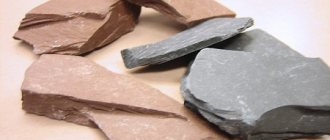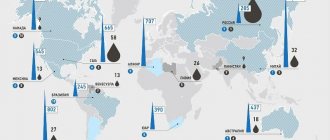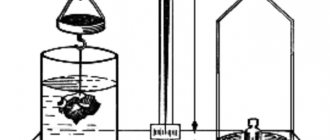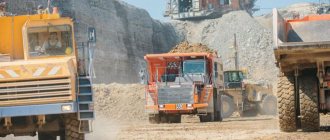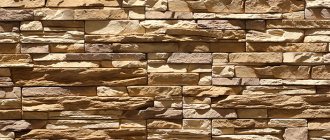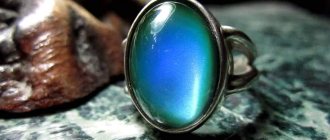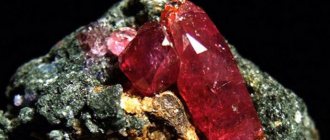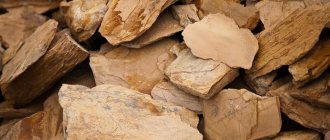There are a huge number of unique minerals in nature that help people create devices and household items. For example, slates are used as the main component in construction; its properties make it possible to create the top layer of the roof.
Slate is a popular type of rock that is highly durable and resistant to sudden temperature changes.
etymology
Designation of parautochthonous mica shale member, English Parautochthonous unit of sikaschists
or abbreviated
PMU
, due to the fact that their breeds are part of the parautochthonous Saint Mathieu Doms found.
The exact position of this convexity of the basement is not clear, and your autochthonous character is in question. This uncertain fact is contained in the prefix Para
of its expression.
Thus, parautochthon means belonging to
or
located next to an autochthon
.
Artificial slate
Artificial stone slate
Natural slate is widely in demand as a finishing material, but not everyone can afford it. This fact served as a reason for the production of a synthetic analogue of slate from cheaper materials. For this purpose, cement, gypsum, adhesive strengthening compounds and dyes are used.
Artificial slate has both advantages and disadvantages compared to natural stone.
The advantages include:
- lightness;
- wide range of color palette.
The disadvantages of the natural stone analogue are:
- use exclusively for interior decoration in dry rooms, since gypsum is not resistant to moisture;
- lack of a pattern on the surface characteristic of real slate.
It should also be noted that only real minerals have healing and magical properties, so you should not count on their manifestation by an artificially created stone.
introduction
General geological map of the Cathedral of Saint-Mathieu
That the Variscan orogen has undergone multi-stage development and is welded from several segments of the crust. In general, two cycles can be distinguished. After the initial subduction from the Central Ocean Massif with high pressure metamorphosis, it finally came to a continental collision between Peri-Gondwana in the south, Laurussia in the north and the intermediate microcontinents Armorica and Avalonia.
Like the rest of Saint-Mathieu-Dome, the parautochthonous mica schist belongs to the Ligero-Arvernian zone of the northwest Massif Central. It is for the Moldanubian zone equivalent to Germany (e.g. Black Forest) and represents the highly metamorphic central part of the variscus. This central zone is characterized by four or five ceiling blocks that occurred during the Variscan continental collision with the Upper Devonian and during the Subcarbons were stacked on top of each other. In Limousin the following ceiling masonry can be observed (from higher structure to lower structure):
- Genis unit
- Thivier-Paizac unit ( TPU
) - Upper Gneiss Gut ( UGU
) - Lower Gneiss Gut ( LGU
) - Parautochthonous Mica Shale Member ( PMU
)
The parautochthonous micaceous schist unit is located opposite the geological map from the PMU
excluded. It is distinguished from the two superimposed gneiss covers, since the first stage of deformation D 1[1] of the Central Massif (subduction and high-pressure metamorphosis) during the Silursian and Lower Devonian (age 430 to 390 million years) is not recorded.[2 ] Both gneiss nappes then underwent high-grade regional metamorphosis in Central Devon. Migmatite formation.[3]
The second stage of deformation, D 2, involved the entire nappe pile in the Upper Devonian and earliest Lower Carboniferous (390 to 360 million years ago), with the lower three layers of the nappes being largely metamorphosed by the amphibolite facies. The rocks generally received a tension line directed to the southeast, which reflects the direction of the hanging shear to the northwest. In the Lower Carboniferous (Tournesian), between 360 and 350 million years ago, the upper part intersected the lower gneiss sheet with the underlying parautochthonous micaceous schist layer in a northwesterly direction.[4] Since the top blanket of gneiss has previously undergone more metamorphosis, this simulates "reverse" metamorphosis. A thermal event that occurred between 350 and 325 million years ago. Viseums are like Monazital found in mica schists.[5] 325 million years ago, extensional tectonics and transpressive environments dominated. Lateral displacement of a pile of blankets in the limousine. As a result of the pressure release, Anathexis occurred and the invasion of predominantly Leuco granites in the upper carbon occurred.
distribution
Pensol mica schist - silky, lustrous facies
The parautochthonous member of micaceous schist is distributed throughout the Massif Central. It appears not only on the eastern edge of Saint-Mathieu-Dôme, but also further east in the frame of the Millevache Massif, for example in the Suzac Cathedral. Further occurrences can be found in Monts d'Ambazac and the Plateau d'Egurande. East of Sillon Huilliers - a large north-northeast impact lateral displacement with a normal offset, cutting through the entire central part of the massif and separating the western section from the central part of the volcano - it appears again in the area of Sioule in the Cathedral of Sioule (in the Anticlinorium of La Bosse a also in the southern part east of the Pont de Menat Synclinorium), which is also a bulge in the basement. The Solder schist and the Cévennes mica schist are both also part of the parautochthonous mica schists, but in addition to the mica schists also have other siliciclastic lithologies, such as Quartzites and the rare Orthogneiss. The parautochthonous mica schist member also appears in the south of the Massif Central at Rouergue and in the central Montagne Noire.
Physico-chemical characteristics
In terms of composition, the shale rock is a conglomerate of metal oxides with a complex formula.
From half to three quarters of the composition is aluminum, almost a quarter is silicon. The remainder is divided into iron, calcium, magnesium, titanium, mica, and other impurities.
There is no single indicator for many characteristics of the rock (hardness scale, color, flammability, water permeability).
Petrology
Petrologically, the parautochthonous mica schist consists predominantly of medium and high mica schists. Degree of metamorphosis (Amphibolite facies). There may be two facies. They are distinguished - sheet and silky glossy facies. into sheet facies
more coarse-crystalline and relatively thick layers of mica who liked thin quartz strips to attach.
The silky glossy facies
is much finer-grained and owes its slightly bluish tint to the pronounced surface of the foliage. The foliage facies is densely shale with partly finely corrugated shale surfaces. Your structure is lepidoblastic or grano-lepidoblastic or almond-shaped layers. It is found only in the northern section on the eastern edge of the river. Saint-Mathieu-Leukogranits on. The structure of the silky glossy facies is similar, but more prone to banding.
mineralogy
Detail of mica schist from Pensol, Haute-Vienne - silky, shiny facies
The very fine-grained and distinctly schistose rocks are clearly identifiable by mica minerals controlled. They contain the minerals Moskvich, Biotite, Feldspar and quartz. Accessories include Zircon, Apatite, Ilmenite, Rutile and also graphite. As metamorphic new formations appear on the foliation plane, Needles from Staurolite and Sillimanite, also very rarely Thistle, as well as small garnet (Almandine). However, garnets can become much larger in deciduous facies, reaching up to 1 centimeter. Caused by contact metamorphoses of Andalusite, Cordierite and acicular Tourmaline. Chlorite is a hydrothermal alteration mineral and can pseudomorphically replace biotite and garnet.
Coarse-grained muscovite predominates, often in the form of sericite. Quite large leaves of muscovite and biotite usually interpenetrate each other and make up most of the mica layers. Due to the inclusion of ilmenite needles, the mica structure can also appear fibrous. Quartz is often almond-shaped (exudative quartz) but sometimes also has tectonically elongated stems; The ribbon-like layers may also have a fine fold. Belonging to Plagioclase lies either as Oligoclase or Albite Forthcoming6-10). Together with quartz it usually forms small, millimeter-sized, elongated forms. eyes (Ocelles), which in deciduous facies reach much larger sizes. The eyes can also be trained.
geochemistry
The following analyzes should clarify the chemical composition of mica schist:
| Oxide Mass% | Mica slate 1 | Mica slate 2 | Mica slate 3 | Quartz mica slate |
| SiO2 | 60,20 | 58,30 | 56,40 | 65,05 |
| TiO2 | 0,83 | 0,95 | 1,04 | 0,82 |
| Al2O3 | 19,20 | 20,90 | 21,60 | 17,00 |
| Fe2O3 | 2,10 | 2,46 | 2,60 | 2,32 |
| FeO | 5,55 | 5,40 | 4,25 | 4,24 |
| MnO | 0,38 | 0,39 | 0,17 | 0,32 |
| MgO | 2,15 | 2,20 | 2,40 | 2,15 |
| CaO | 1,20 | 1,06 | 0,45 | 1,27 |
| N/A2O | 1,30 | 0,91 | 1,05 | 1,87 |
| K2O | 3,75 | 4,15 | 5,10 | 3,43 |
| P.2O5 | 0,23 | 0,13 | 0,09 | 0,22 |
| HOUR2O- | 0,05 | 0,06 | 0,20 | 0,03 |
| HOUR2O | 2,35 | 2,60 | 3,25 | 1,63 |
SiO2- The content of mica schist ranges from 56 to 60 percent by weight, quartz-rich rocks reach 65 percent by weight. This corresponds to the Andesite chemistry accordingly. Diorites. High Al hits 2O3-Content from 17 to 22 percent by weight, but also with very strong iron oxide content from 6.5 to 7.8 percent by weight. TiO also shows fairly high values2 and MgO. Alkalis, especially Na, are usually depleted in 2O.
Links[edit]
- ^ ab "Shale Definition". Dictionary of Geology
. Retrieved July 12, 2013. - Jackson JA, Mehl JP & Neuendorf KPG (2005). Glossary of Geology. Springer. item 577. ISBN. 9780922152766.
- Jump up ↑
Bishop AC, Woolley AR & Hamilton WR (1999). The Cambridge Guide to Minerals, Rocks and Fossils. Cambridge University Press. item 153. ISBN. 9780521778817. - ^ ab Fundamentals of Geology, 3rd ed., Stephen Marshak
- J., Tarbuk, Edward (2012). Earth Sciences
. Lutgens, Frederick K. (13th ed.). Upper Saddle River, NJ: Prentice Hall/Pearson. ISBN 978-0321688507. OCLC 693684089. - "Slate". English dictionary
. Oxford University Press. Retrieved February 10, 2014. - R. W. Raymond, Slate, Glossary of Mining and Metallurgical Terms, American Institute of Mining Engineers, 1881, p. 78.
- ^ ab One or more of the preceding sentences incorporates text from a publication now in the public domain: Flett, John Smith (1911). "Petrology". In Chisholm, Hugh (ed.). Encyclopedia Britannica
.
21
(11th ed.). Cambridge University Press. item 333.
metamorphosis
Vergent folded mica schist sheet facies
Parautochthonous mica schists have experienced both regional and contact metamorphoses. Metamorphic mineral formations of the regional metamorphosis are muscovite, biotite, garnet, staurolite, sillimanite (fibrolite), associated with muscovite and thistle. The pomegranate may have formed before, during, or after foliage formation. It can be zoned, with edges rich in almandine and Spessartine at the base. Staurolite is a late formation. The occurrence of kynthene generally indicates pressure conditions of at least 0.4 GPa to 0.6 GPa, and staurolite indicates temperatures above 600 °C. However, pressures were likely much higher—for example, conditions of 0 were reached in the Siule mica shales .8 GPa.[6]
Contact metamorphosis caused by the Saint-Mathieu leucogranite resulted in the formation of poikiloblastic cordierite and andalusite, both disrupting/overlying the bedding, but also alkali feldspar. In addition, continuous tourmalinization occurred, and at the same time garnet was replaced by biotite and chlorite or pseudomorphically by biotite, muscovite and quartz.
Anathexis
The parautochthonous mica schist unit is very closely related to and also related to the Saint-Mathieu leuco-granite. Chéronnac leuco granite bound. Numerous inclusions of micaceous schist are found in both Leuco granites, some of which can be designed as kilometers of trains. On the contrary, lenses and apophyses of leucogranites are found in micaceous schists. Therefore, it can be assumed that the mica schist is under pressure release. anatectic were molten and leucogranite magma secreted. The Saint-Mathieu leucogranite dates back to 315 million years ago, and anatexis thus took place in the Upper Carboniferous of Bashkiria.
Price
In Russian online stores you can buy construction materials, collection materials, and other products (price, rub.):
- ax (gift for a man) – 11,200;
- figurine (210x70 mm) – 1,200;
- cabochon (pyrite in slate, 44x25x5 mm) – 510.
There is a wide range of building materials. And the price depends on the place of extraction and the manufacturer.
Domestic facing tiles will cost 450-850 (m2). The cost of imported, for example, from the Brazilian breed, is from three thousand rubles.
tectonics
Wrinkle with closely spaced jagged edges on deciduous facies
By lowering them into the plastic middle Crust area The former clay deposits were given a permanent flattening and resulted in flat foliage due to enormous stress, partly due to tectonic factors. By crawling across the shale surface, small, quartz-feldspar-rich almond structures and eyes were created, which sometimes also exhibit a shear sense. The stretched quartz rods also indicate the direction in which the rock was pulled. Tectonic nodes have locally resulted in wrinkling in the centimeter range (sometimes also isoclinal and foliated), which in turn can be overlain by very closely spaced teeth in the millimeter range. In some places, late fracture folds and very complex fold patterns are observed, indicating intense deformations (interference patterns). With the advent of Saint-Mathieu-Dôme and the ceilings above (emerging from the plastic zone), the mica schist was subjected to only brittle stress. Residual stresses in the rock can spread Faults and division flocks can be dismantled.
Therapeutic effect
Energetically strong shale creates a positive effect on human health:
- The stone calms the nerves, eliminates stress, tension, apathy, and anger.
- The heated mineral is applied to the site of a cut, inflammation, or wound to speed up healing.
- The stone can be left in clean water overnight. And in the morning drink it as a preventative or cleansing agent for the body.
- For healthy, calm people, the stone is useful as a guarantor of maintaining physical and mental health.
Slate is a talisman-assistant to creative and artistic people.
Knowledgeable people recommend tiling at least one room in a house or apartment with slate. Health will improve, emotions will be under control.
I mean
Parautochthon mica schist from Cévennes Saint-André de Valborgne - with very fine crenulation
The importance of parautochthonous mica schist rests on the fact that it is due to its fine-grained clay layer. The lithology is an ideal lubricant for high ceilings, which could penetrate the back with significantly reduced frictional resistance in the west and southwest while draining in the northwest-southeast direction. Therefore, their deep tectonic position (like the bottom of a deck) is not surprising.
Physical properties and deposits of stone
Slate is a popular type of rock that is highly durable and resistant to sudden temperature changes. The stone is waterproof and fireproof. Under the influence of the environment, it can turn into crystalline slate, which easily splits into plates.
Observations of minerals began in the 19th century in Buryatia. While studying the characteristics of minerals, Prince Kropotkin noted the wide variety of shale ores. In the Tunka Basin, where there was previously a deep lake, eroded rocks were discovered. This fact made it possible to establish the influence of environmental conditions on the formation of valuable minerals.
The United States is one of the leaders in shale ore production. Countries such as Russia, China and Poland are not far behind. Since 2012, the term “shale revolution” was introduced. This designation indicates the active introduction of shale rocks into industry and the efficient use of natural gas. Slate dishes are famous for their beauty and affordable price.
Slate is waterproof and fire-resistant
Individual evidence
- J.-M. Lardo et al.: The Central French Variscan Massif - a new addition to the ultra-high pressure metamorphic "club": exhumation processes and geodynamic consequences. In: Tectonophysics. Tape 332, 2001, pp. 143–168.
- M. Faure et al.: Devonian geodynamic evolution of the Variscan Belt, insights from the French Massif Central and the Armoricain Massif. In: Tectonics. Tape 27, 2008, Doi:10.1029 / 2007TC002115.
- A. Cocherie et al.: Electron microprobe dating as a tool for understanding the closure of the U-Th-Pb system in migmatite monazite. In: V. Mineral. Tape 90, 2005, pp. 607–618.
- J.-Y. Roig and M. Faure: La tectonique cisaillante polyphasée du Sud-Limousin (French Massif Central) and its interpretation in the model of the evolutionary polycyclic chain of Hercynia.. In: Bull. Soc. geol. Pt.Lenta 171, 2000, pp. 295–307.
- M. Faure et al.: Late Visean thermal event in the northern French Massif Central: new 40Ar/39Ar and Rb-Sr isotopic constraints on the Hercynian synorogenic extension. In: Int. J. Earth Sci. (Geol. Rundsch.). Lenta 91, 2002, pp. 53–75.
- Bernhard Schulz: EMP-monazite age controls on PT trajectories of garnet metapelites in the inverted Variscan La Sieule metamorphic sequence, Massif Central. In: Bull. Soc. geol. Fri. vol. 180, no. 3, 2009, pp. 271–282.
